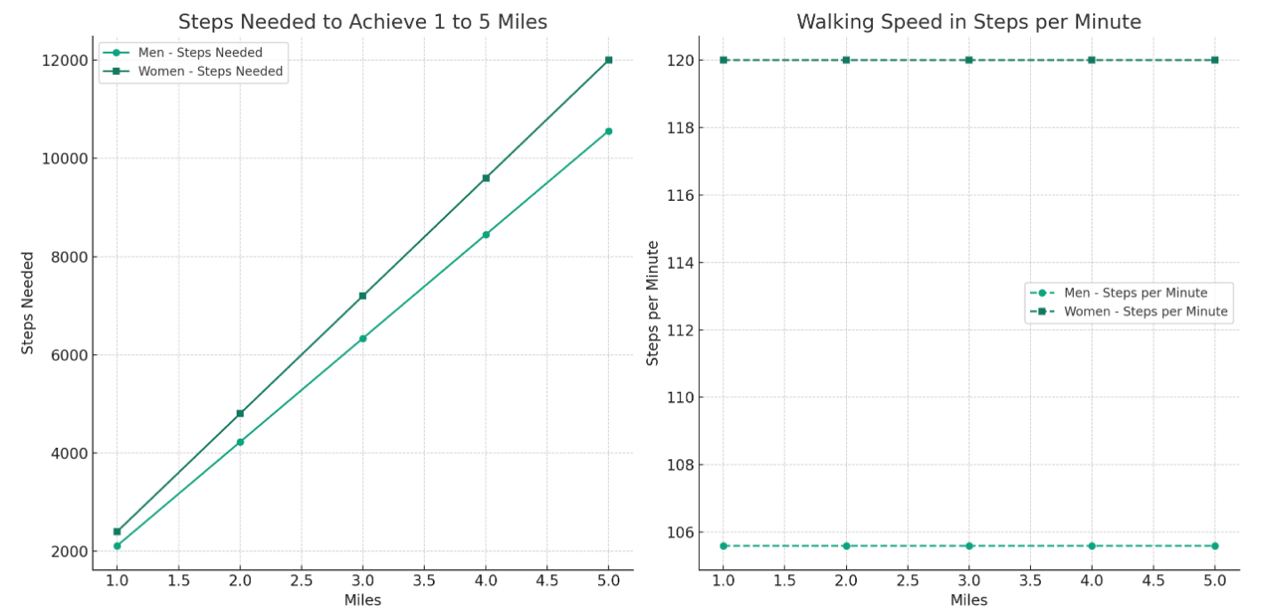Steps to Miles Converter
Accurately calculate how many miles your steps have covered
Convert Your Steps to Miles with Ease!
Our website offers a quick and easy way to convert the number of steps you take into the distance you've covered in miles. Whether you're trying to reach a daily step goal or simply curious about how far you've walked, our step-to-mile converter is the perfect tool for you. With a user-friendly interface and accurate calculations, you can track your progress and stay motivated to achieve your fitness goals. So why wait? Start converting your steps to miles today and take your first step towards a healthier, more active lifestyle!
How are steps to miles calculated?
To calculate the number of miles you've walked based on your step count, you can use the following formula: Miles = Steps * Stride Length / 5280 where "Steps" represents the number of steps you've taken, "Stride Length" is the average length of your stride in feet, and "5280" is the number of feet in a mile.
To find out your stride length, you can measure the distance between two consecutive steps you take when walking at a comfortable pace. You can then divide this distance by the number of steps taken to get the average length of your stride.
If you know the speed at which you are walking, you can calculate the distance you've covered using the following formula: Distance = Speed * Time where "Speed" is your walking speed in miles per hour and "Time" is the duration of your walk in hours.
Why Convert Steps to Miles?
Goal Setting and Achievement: Converting steps to miles can help you set tangible distance goals, like "walk the equivalent of my city to the next" or "complete a marathon's distance over a month." It's a fun and engaging way to keep fitness interesting and challenging.
Health Insights: Knowing how many miles you walk in a day can offer insights into your overall health. Health organizations recommend walking a certain number of miles daily to maintain heart health and manage weight. Our converter helps you track these milestones effortlessly.
Motivation Boost: Seeing the miles rack up can be a significant boost to your motivation. It's one thing to see 10,000 steps on your tracker; it's entirely another to know those steps equal five miles! It transforms your daily walks into achievements worth celebrating.
How Our Converter Works
Our converter is designed with simplicity and accuracy in mind. Just enter your daily step count, and if you know your average step length, you can input that for a more precise conversion. Not sure about your step length? No problem! We provide a default based on average data, ensuring you still get a close estimate of the miles you've covered.
F.A.Q
- Determine the stride length - measure it or assume
2.2 ftif you're female and2.5 ftif you're male. - Multiply the stride length by the number of steps, e.g.:
2.2 ft × 1,000 = 2,200 ft. - Convert the result to miles:
2,200 ft / 5,280 ≈ 0.42 mi.
10,000 steps per day for overall health and to help reduce the risk of chronic diseases.
- Improves cardiovascular health: Walking is a great form of low-impact exercise that can help improve your cardiovascular health.
- Helps with weight management: Walking is an effective way to burn calories and manage your weight. Even a short walk can help boost your metabolism and burn calories.
- Boosts mental health: Walking can have a positive impact on your mental health as well. It can help reduce stress and anxiety, improve your mood, and boost your overall sense of well-being.

References
When seeking reliable sources for calculating steps to miles, it's crucial to reference websites that offer not only conversion tools but also provide insights into the methodology and factors influencing these calculations. Here’s a list of reputable websites that can serve as valuable references:
CDC (Centers for Disease Control and Prevention): Offers guidelines and insights into physical activity, including how steps and distances can contribute to daily exercise recommendations. Website: https://www.cdc.gov
Mayo Clinic: Provides a wealth of health-related information, including the benefits of walking and how to count steps effectively. Website: https://www.mayoclinic.org
MapMyWalk (by Under Armour): Besides being an app for tracking walks, the website offers articles and tools related to walking distances, step counts, and fitness planning. Website: https://www.mapmywalk.com
American Heart Association: Offers guidance on how walking can improve heart health, including steps-to-miles conversions to meet daily physical activity guidelines. Website: https://www.heart.org
Walking for Health (UK): Sponsored by the UK’s National Health Service (NHS), it provides resources for starting walking groups and improving health through walking, including understanding distances covered. Website: https://www.walkingforhealth.org.uk








